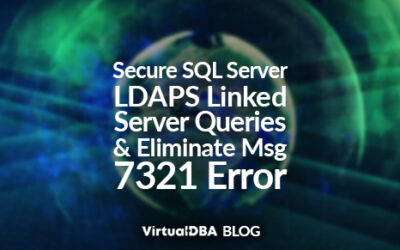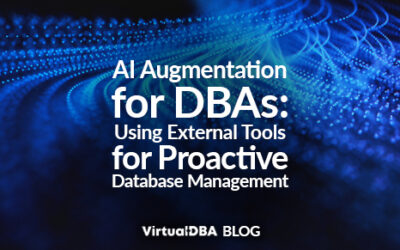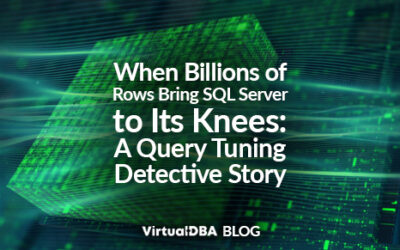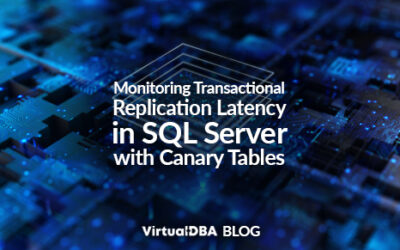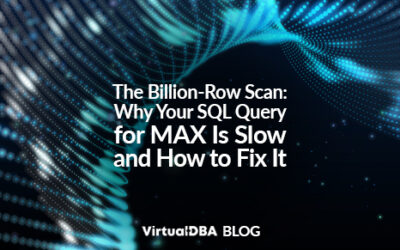Table of contentsThe "Oops, Did I Just Buy a Ferrari When a Bicycle Would Do?" SyndromeXTIVIA: Your MySQL Cloud Cost-Cutting CrusadersWe Speak All Cloud MySQL DialectsLet's Get Your MySQL Budget Back on Track! MySQL, the trusty open-source database, is a favorite for...
Welcome to our blog, which is more than just a record of our experiences. It’s a resource.
Our blog is an invaluable resource for anyone struggling with the challenges of managing a database, applications, or clouds.
We understand the difficulties involved in troubleshooting, building, improving, securing, and operating these platforms,
and we’re here to share our insights and expertise with you. Browse through our collection of blog posts below,
and don’t hesitate to leave your comments and feedback.
Secure SQL Server LDAPS Linked Server Queries and Eliminate Msg 7321 Error
Table of contentsThe Challenge: Remediating LDAP Simple Bind in SQL ServerThe Initial Query: A Standard ADSI OPENQUERYThe LDAPS:// Pitfall and the Dreaded Msg 7321The Correct Approach: Explicitly Defining the Secure PortBeyond Syntax: A 3-Step Security Validation...
AI Augmentation for DBAs: Using External Tools for Proactive Database Management
Table of contents1. Proactive Performance Tuning & Predictive OptimizationDeeper Dive & Examples (Why AI is Better Than By Hand):2. Advanced Anomaly Detection in Database Security & AuditingDeeper Dive & Examples (Why AI is Better Than By Hand):3....
Linux OOM Killer Terminated mysqld and How to Recover
One morning, I was alerted that a crash had been detected by our monitoring scripts. Upon reviewing the error log, a crash was noted. Error log:250608 02:27:07 mysqld_safe Number of processes running now: 0250608 02:27:07 mysqld_safe mysqld restarted. . . . . . . . ....
Adding an Article to Replication Without a Full Snapshot
SQL Server Transactional Replication is a powerful tool that can address many challenges in your environment. Setting up Replication is not difficult, but it can be time-consuming, depending on the amount of data you need to replicate. This is why some people dread...
When Billions of Rows Bring SQL Server to Its Knees: A Query Tuning Detective Story
Table of contentsThe Setup: A High-Stakes Data TransferThe First Clue: A tempdb Under SiegeThe Usual Suspects: A Process of EliminationThe Smoking Gun: When Parallelism Turns Against YouThe Final Showdown: Trusting Your GutLessons from the Trenches The Setup: A...
Monitoring Transactional Replication Latency in SQL Server with Canary Tables
I was recently asked by a client to set up an easy way to monitor Replication Latency in SQL Server. The client wanted to be notified whenever data took more than 10 minutes to reach its destination. SQL Server does provide some built-in methods to help with this,...
The Billion-Row Scan: Why Your SQL Query for MAX Is Slow and How to Fix It
Table of contentsA Simple Query with a Devious ProblemWhen Partitioning Works Against YouThe Counterintuitive Fix: Adding a "Duplicate" KeyDon't Trust the Icon: Read the Real Execution PlanKey Takeaways for Data Professionals A Simple Query with a Devious Problem It's...
Why SQL Server 2025 Is AI-Ready with Microsoft Fabric—and How XTIVIA Can Help
Table of contentsWhy SQL Server 2025 is AI-Ready: The Future of Data Management1. Seamless AI Integration in SQL Server 20252. Performance Enhancements for AI Workloads3. Predictive Analytics and Automated InsightsThe Role of Microsoft Fabric in SQL Server 20251....


